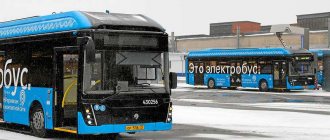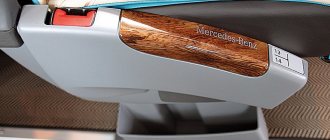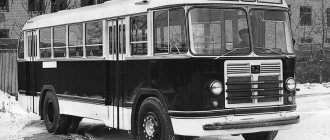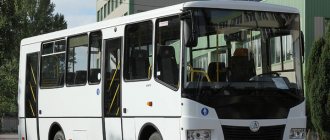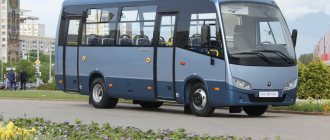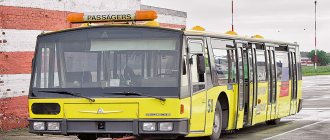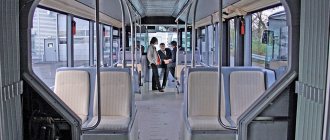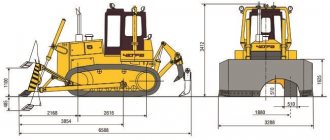Electrical engineering: new Volgabus-electric bus and Matreshka
The closer the appearance of the first electric buses on the streets of Moscow, the more people want to produce these same electric buses. GAZ and KAMAZ have already demonstrated their vision of the capital’s future electric transport, and now it has arrived). At the Transport of Russia exhibition, I got acquainted with the new Volgabus electric bus, and also learned how the Matreshka project drones are developing.
With its bright and original appearance, the electric Volgabus, named CityRhythm-12E, can give all domestic competitors a head start. There are rounded headlights, a broken window line, and taillights with a memorable curved shape. It turned out to be a beautiful car! Interestingly, the company’s regular buses will also have a similar appearance in the near future.
The completely low-floor cabin can accommodate up to 90 people, 28 of whom can be seated. Moreover, all the chairs are placed on large massive podiums. Below them are batteries. This is the main difference between Volgabas and its competitors, since the same LiAZ-6274 and KAMAZ-6282 electric buses have batteries placed on the roof, which creates an additional load and increases the center of gravity. So - bravo, Volgabus?
Not really. Those same podiums took up so much space in the cabin that the aisles turned out to be narrow, and only a platform for a wheelchair could be placed behind the central door. There is nowhere to put chairs for people with limited mobility, which must be installed directly on the floor. In its current form, Volgabus does not comply with the Moscow technical specifications. The developers know this, so in the following options some of the batteries will still displace the air conditioning unit on the roof.
By the way, there are no accelerated air charges on the roof: Volgabus, like LiAZ, is designed to operate on the principle of night charging from the network (we will definitely tell you about the types of electric buses someday). The power of the traction electric motor is 115 kW (versus 160 kW for LiAZ). But batteries produced by Liotech have a total capacity of 300 kWh (as opposed to Liazov’s 130 kWh), but their full charging time is correspondingly longer - at least six hours versus Liazov’s four.
The declared range in city mode with the heater on (and it is electric here, not diesel like on LiAZ, and more recently on KAMAZ) is as much as 200 km. Overpriced? But the same LiAZ ran about 75 km on one charge in test operation in Moscow, so you can believe in the assurances of the developers that the Volgabus (the battery capacity of which is almost two and a half times greater) in operating mode can cover 150-180 km .
With Liotech batteries, the cost of an electric bus should be approximately 23-25 million rubles. If imported analogues, say Toshiba, are used, the price will jump to 30 million. But whether there will be orders for the Volgabus electric bus is still an open question. Moreover, the appearance of such cars is more likely not even in Moscow, but in St. Petersburg. There are 450 regular company buses operating there, and an electric bus built on the basis of the previous generation of buses will also be tested all winter - we will definitely ride it!
MatrЁshka in the foreground is a cargo one, in the back is a passenger one
Another project of the BMG company is also being developed - Matreshka drones, which we have already talked about. A cargo version has also appeared in the hardware - although for now it is in the form of a mock-up. It is assumed that such shuttles will be able to transport containers around in-plant or warehouse premises. A touch screen is built into the model’s body (which, upon closer inspection, turns out to be an “iPad”), from which it will be possible to send the machine to a specific point.
But the passenger Matreshka is already a running copy. Such machines have been tested in closed areas for some time. For example, they went to Skolkovo, and are now being tested at the site of one of the factories in Moscow.
Of course, since their inception, drones have been constantly modernized. First of all, this affected the updated software, but there are also technical changes. Thus, video cameras, which are the “eyes” of the autonomous shuttle, are now located in closed chambers with a constant temperature.
As for the interest in “matryoshka dolls” in general, many people have a desire to try out drones, but no one is ready to buy a full-fledged “matryoshka doll farm” (cars and a coordination center), which will cost about 10 million rubles a year.
Bet on Cityrhythm12E
The bus has an interesting design: a laconic, recognizable front end, LED rear lights, an unusual line of side glazing, a fashionable geometric pattern of the engine air intake... Such beautiful buses have never been made in modern Russia! The new model should become for Volgabus approximately the same as Lada Vesta became for AvtoVAZ, a kind of transition to the next level.
Now the main production facilities of Volgabus are concentrated in the city of Volzhsky, Volgograd region, but at the end of last year the company opened a new large plant in Vladimir, equipped with the most modern equipment. Simultaneously with the opening of production, the company decided to update the entire line of buses. It is the Cityrhythm that has received the most serious changes and is demonstrating a new “company face”, which other models will soon try on.
The team of Anton Kuzhilny, one of the authors of the sensational futuristic concept tram UVZ R1 (which never went into production), is working on the design of promising Volga buses. The studio, located in Moscow's Kalibr technology park, employs only nine people: three designers, two constructors, a 3D modeler, a graphic designer, a manager, and Anton himself, the chief designer. The studio team is mostly MAMI graduates with experience in Marussia, Cardi, NAMI and Moscow industrial design studios.
The basis of the Cityrhythm is the frame of the previous bus model, but it is lightweight and redesigned to fit the new contours of the windows. The strength calculations were carried out by CompMechLab from St. Petersburg. While competitors from Tatarstan are betting on electric public transport with a range of 70-80 km and periodic recharging using a pantograph during the working day, the team from Volzhsky decided that the battery capacity should be enough for the entire working day (200-300 km mileage), and the batteries must be charged at night in the bus depot (5 hours at 380 V). For Volga residents, the car is more expensive due to the larger number of batteries and is heavier. The electric version of Cityritm is twice as expensive as its diesel counterpart - about 20 million rubles. Based on the realities of domestic passenger transportation, the concept of electric transport with battery capacity for the entire working day is more efficient than buses that require pantographs or other fast charging systems at final stops.
The difference in the cost of diesel fuel and electricity can save up to 850 thousand rubles. in year. Taking into account all the operational components, it is impossible to say with confidence that the cost of owning an electric bus is lower in comparison with diesel or gas analogues, but the main task of such transport is not saving in operation, but improving the environmental situation in cities.
One of the features of the Volga car is a regular portal axle with a gearbox without wheel electric motors, as is customary now. The electric motor itself is located in the motor shaft and transmits torque to the axle using a cardan shaft. Time will tell whether this arrangement has more advantages or disadvantages, but the idea is clear - to reduce the cost of the car by abandoning expensive imported components.
The Cityrhythm salon is completely new, modern and comfortable, without steps in the doorways. But there are fewer bright solutions here than outside. The only thing you can notice is the pattern on the glass partitions - the same as on the engine grilles, and the electronic instrument panel. The steering wheel, by the way, is the same as that of the German MAN - it is too expensive to develop and certify your own. Work on the interior is still ongoing - this is what designers are currently working on.
“Making a “bus with design” was not a priority, this is not our main goal. First of all, we tried to simplify the assembly of the interior, make it simple and quick. We’re mostly working on this,” comments Anton. The methods are the same as in the passenger car industry: “We now have the engine shaft casing, which separates the engine from the passenger compartment, from four composite panels, but the assembly is still too complicated, now we want to do it in one piece.”
Since the new Volgabus plant is designed to produce up to 5,000 buses per year (previously several hundred were produced), all technologies are adapted for a large series. For example, interior elements previously made of plywood and floor covering - wheel arch covers, seat podiums - should become composite. Anton admits that in terms of technology he focuses on European buses: “While I am against any inventions, we look at what others do, learn, try to do better. Now we can use technologies similar to those used by small companies like Van Hool or VDL, but we strive for what Mercedes or MAN do.” By the way, once again about the cost of design solutions. The exhibition vehicle is equipped with Ster seats, specially purchased in Poland at a price three times more expensive than domestic ones. Such seats will not be installed on production buses.
However, everything is up to the will of the customer: “In essence, we are not developing a bus, but a construction set, a set of elements from which the buyer assembles the option he needs.
Selects the length of the bus, the number of seats, and the interior layout. All cities have different requirements. For example, in Moscow the driver exits through the passenger compartment, but in St. Petersburg he has a separate door. The route board is also installed at the buyer’s discretion; it is not needed at all on school buses.” There are three types of power plants for Cityrhythm: electric (like the exhibition car), diesel or gas. Here again the principles of unification and modularity are used. The dimensions of the bus are as follows: length - 11,990 mm, width - 2500 mm, wheelbase - 6000 mm. The number of seated passenger seats is 30, with standing seats the cabin capacity reaches 90 people.
Share
BUS-CLUB.RU
November 28, 2017 New equipment always attracts attention, and if it also has an original color, then it is impossible to pass by and not notice the new product. Bright yellow, with sunflowers on the sides, the Volgabus 5270G2 city bus became a unique decoration of the streets of Krasnodar for 4.5 months. The test operation of the machine recently ended. Time to take stock text: Oleg Bodnya / photo: author
Volgabus 5270G2-010. Overall length: 12 m. Start of sales: 2015 Price: n. d.
The cabin interior is simple but functional
Despite the fact that the Volgabus 5270G2 model has been in production for two years now, many industry specialists know gas buses from Volzhskoye at best from specialized exhibitions. Providing a vehicle for trial operation with passengers is a good way to introduce operators to your products and show the product in person. And if previously this honor was awarded mainly to metropolitan transport companies, now new equipment is actively promoted to the regions.
The entire catalog of VolgaBus buses
The bus entered the Krasnodar streets thanks to the initiative of the local dealer of the Volgabus group of companies. The vehicle was placed at the disposal of the main city carrier, the Krasnodar Tram and Trolleybus Administration, which, in addition to electric transport, owns about 200 buses. The tests were entrusted to specialists from trolleybus depot No. 2, who have experience working with gas equipment. Since 2010, the company has been servicing 30 NefAZ vehicles with KAMAZ CNG engines. In 2015–2016, the MAZ203 bus, also equipped with gas cylinder equipment, underwent trial operation at the depot.
The Volzhsky bus was handed over to the depot employees on February 14 and two days later it entered the “front” city route No. 2E. The new product ran along this route every weekday; work shifts averaged 10–12 hours (with lunch breaks). The last day of work on the line is June 27. Thus, the trial period was approximately 4.5 months. During this time, the vehicle covered 11,533 km. The odometer reading at the end of testing was 13,255 km.
The control panel contains almost the entire set of necessary keys and instruments; on the periphery there are only the parking brake and panels of secondary systems
The Volgabus 5270G2 is a standard 12 meter, fully low-floor, large class bus. 28 seats, maximum capacity - 111 people. If you have a child or wheelchair, the total capacity of the cabin is reduced by 7 seats. There are three passenger doors, with one of the front door wings used by the driver (wide cab). There is a folding ramp for strollers in the middle door opening.
The layout of the passenger compartment is optimal. The seats are arranged correctly and are comfortable for passengers. The number of podiums has been reduced to a minimum, as a result of which 8 seats have been placed in the low-floor part of the cabin. Their number can be increased by at least 2 - naturally, with a parallel decrease in the total capacity of the bus. The designers have provided for this and many other design options for the passenger compartment, so when viewing the vehicle type approval, you feel like a wealthy client choosing a product from a catalog: your eyes literally run wild from the proposed layout solutions.
The driver's seat is also convenient and comfortable. All the main parameters are displayed on the dashboard in the form of arrow indicators, while the function of the indicator panel is performed by a small monochrome display of the on-board computer. All the main keys responsible for controlling the machine are located on the side panels. On the left side of the driver are the parking brake lever, control panels for the climate system and fire extinguishing system, on the right is the tachograph, as well as control panels for the auto-informer and satellite navigation system.
The layout of the pedal assembly requires improvement
Disadvantages noticed during trial operation include the inconvenient location of the pedals: they are installed with a slight offset, which, during long-term operation, leads to tired legs of the drivers. The dashboard materials are also not durable enough: several commonly used buttons had to be strengthened or replaced due to physical wear and tear.
VolgaBus bus forum
Let's take a closer look at the “filling” of the bus. The power unit includes a 6-cylinder in-line Yuchai YC6L280N-52 engine producing 280 hp. With. and an automatic 4-speed transmission Voith Diwa 854. Thanks to the use of natural gas, the Euro 5 environmental standard is achieved without any additional systems or reagents.
The front steering axle is ZF RL85A, the rear driving axle is ZF AV132, both with disc brakes. The suspension in both cases is dependent, on air springs. The kniling system, which has already become a mandatory attribute of low-floor equipment, is available. The bus is equipped with specialized TyRex AllSteel VC-1 tires of size 275/70R22.5.
The front panel does not recline, but opens at a slight angle
The main braking system is a dual-circuit pneumatic system, divided into axial circuits and ABS. The role of the auxiliary braking system is performed by the automatic transmission hydraulic retarder (retarder). Disc mechanisms of the front axle are used as a parking brake.
A favorable microclimate in the driver's cabin and passenger compartment is ensured by an Eberspacher Su trak air conditioner with a power of 30 kW (installed on the roof) and a liquid heating system connected to the engine cooling system. The Eberspacher Hydronic diesel heater is responsible for heating the coolant.
As mentioned above, the bus runs on compressed natural gas (methane). The total capacity of gas cylinders located on the roof is 984 liters (8x123 l). One shunting cylinder, seven main. The approximate range, according to the manufacturer, is 400 km. During the tests, the system was not tested for “endurance”: it was refueled daily. The gas volume consumed was in the range of 115–140 m3, refueling time took 15–17 minutes.
The bus was serviced by a specialized service center; depot employees were only responsible for eliminating minor faults. The first maintenance of the car was carried out when the mileage reached 5000 km. The further maintenance schedule is as follows: TO-1 - every 15,000 km, TO-2 - every 30,000 km, plus seasonal maintenance (spring and summer).
Access to units and containers with process fluids is relatively convenient. The back cover rises up and is fixed with gas stops, the front panel goes down at a small angle, allowing you to replace the headlight lamps (there will be some difficulties with the turn signals).
In daily work on the route, the bus has proven itself well - quite at the level of its “classmates” plying the streets of Krasnodar. This is already a good indicator, since the basis of the KTTU municipal unitary enterprise fleet is made up of 3-year-old buses LiAZ-5292, MAZ-103 and MAZ-206, which served the 2014 Olympic Games in Sochi. However, there were some points that needed improvement. Let's look at them in more detail.
Passenger cabin: the optimal combination of seating and storage areas for a low-floor passenger
The first problem is the anti-move system, which blocks the movement of the bus until the doors are completely closed and the brake pedal is pressed for control. In some cases (unfortunately, not uncommon) the system did not work the first time, and I had to press the pedal again. In conditions of a compressed traffic schedule on the route, this led to a lag behind the schedule and a stressful load on the driver. Slow acceleration in 1st or 2nd gears of the automatic transmission, which is unacceptable in heavy city traffic, also had a negative impact on the schedule.
Other shortcomings include the insufficiently powerful power steering and stiff suspension. In addition, seasonal maintenance of the cabin air conditioning was not carried out. The bus tests were completed just in time for the beginning of the summer season, when the air temperature in the city began to reach maximum levels (35 degrees and above). There were already several days in June when the operation of the climate system was not just desirable, but necessary, but when turned on, the air conditioner supplied warm air to the interior and cabin.
The arrangement of units in the rear overhang is traditionally quite dense
The problems described above are mainly solved by reconfiguring or servicing the units. They were brought to the attention of representatives of the dealer company, but were not resolved. As a result, the overall positive impression of the new product was a little blurred. Nevertheless, the bus proved to be a “strong average” and worked without serious failures throughout the entire trial period.
Similar machines are widely used in Vladimir, Volgograd, Volzhsky, Orenburg, St. Petersburg and Tolyatti. As of mid-2022, just over 320 Volgabus 5270G2 units have been produced. The main tool for promoting the model in the regions is the federal program to support environmentally friendly types of passenger transport.
Other modifications of gas Volga buses are available for order: urban semi-low-floor, suburban and intercity. A pilot sample of the 10-meter gas Volgabus is already ready. The model range of buses from Volzhsky continues to expand, which means that new equipment will soon appear at exhibitions, in trial operation and in reviews on the pages of our magazine.
VIKTOR KOSOLAPOV / 1st CLASS DRIVER MUP "KTTU", 52 YEARS OF EXPERIENCE
Working on a bus is convenient: all instruments and controls are at hand. The electronic display displays all the necessary information, the on-board computer monitors the level of process fluids and warns of the need for service work.
For comfortable driving, it is necessary to modify the anti-propulsion system, adjust the settings of the gearbox and bus suspension. In general, the impressions of driving the car are positive.
pros
- Modern appearance, roomy, well-planned low-floor interior, comfortable driver's seat, automatic diagnostics of all major bus systems, powerful engine
Minuses
- Stiff suspension, slow acceleration, unfinished anti-speed system, problems with service support
| Technical characteristics of Volgabus 5270G2-010 |
| Number of seats (standing/seated/disabled) | 83/28/0 or 75/28/1 |
| Total weight, kg | 17 950 |
| Dimensions (length/width/height), mm | 11 990 / 2500 / 3250 |
| Wheelbase, mm | 6000 |
| Curb weight, kg | 10 400 |
| Volume of gas cylinders, l | 984 (8x123) |
| Engine | |
| model | Yuchai YC6L280N-52 |
| type | gas, in-line, 6-cylinder, Euro-5 |
| slave. volume, cm3 | 8424 |
| power, hp | 280 |
| Transmission | automatic, 4-speed, Voith Diwa 854 |
| Brakes | disk |
| Tires | 275/70R22.5 |
| Service | |
| Mileage between services, km | 15 000 |
| First maintenance | after 5000 km |
| Competitors | |
| LiAZ-5292, MAZ-103, NefAZ-52994 | |
Source: https://5koleso.ru Topic: Bus test / New bus models
Volgabus Serpentine[ | ]
Volgabus-5285.00[ | ]
Produced since 2012. 60 buses were produced.[14]
Volgabus-5285.02/Marathon[ | ]
Produced since 2022. 61 buses produced.[15]
Volgabus-5285.05/Delta[ | ]
Produced in 2017-2019. 23 buses were produced.[16]
Volgabus-5285.12[ | ]
Released in 2016. 5 buses were produced.[17]. Operated in Volgograd.
Volgabus-5285.D0/Serpentine D[ | ]
Released in 2016. 23 buses were produced.[18].
Volgabus-5285.D2/Serpentine D[ | ]
Released in 2022. 10 buses were produced.[19].
Volgabus-5285.G2/Serpentine G[ | ]
In 2015, a new modification of the bus was launched into production. 115 buses were produced. Operated in Perm, Volgograd region, St. Petersburg, Leningrad region, Orenburg region, Sosnogorsk, Surgut, Bryansk, Ufa, [20].
Volgabus-4298 Rhythmix[ | ]
Produced in 2011-2012. 3 buses were produced.[21]
Volgabus-4298.00[ | ]
Produced in 2012-2014. 25 buses were produced.[22]
Volgabus-4298.01[ | ]
Produced in 2012-2014. 204 buses were produced.[23]
Volgabus-4298.01-01[ | ]
Produced in 2012-2013. 9 buses were produced.[24]
Volgabus-4298.G7[ | ]
Produced in 2013-2014. 18 buses were produced.[25]
Volgabus-4298.G8[ | ]
Produced in 2013-2015. 89 buses were produced.[26]
Cityrhythm 10[ | ]
Volgabus-5270.0N/Sitiritm 10 DLE[ | ]
Produced from 2022. There are suburban and urban versions (they differ in the interior layout and the middle door). It differs from 5270.00 in length (10 m versus 12 m - shortened) and the absence of a rear door. 281 buses were produced. Operated in the Moscow, Kemerovo and Kursk regions, also operated in the Pskov region from September 2022 to June 1, 2022 by a subcontractor registered in the Moscow region[12]
Volgabus-5270.GН/Sitiritm 10 GLE[ | ]
Produced from 2022. It differs from 5270.G0 and 5270.G2 in length (10 m versus 12 m - shortened) and the absence of a rear door. 253 buses were produced. They are operated in Volgograd, Orenburg, Cheboksary, Lipetsk, Vladimir, Khabarovsk, Novokuznetsk, Kemerovo, Sosnovy Bor, Yaroslavl, Izhevsk, Tyumen, Tomsk, Novosibirsk[13].
